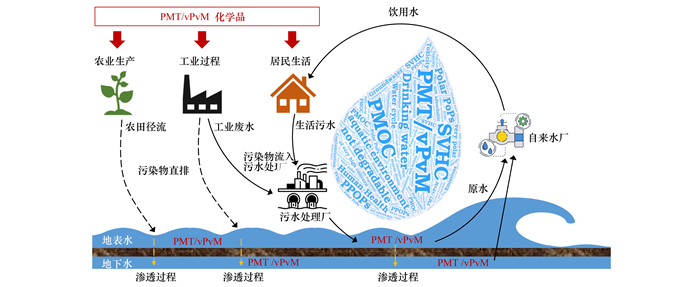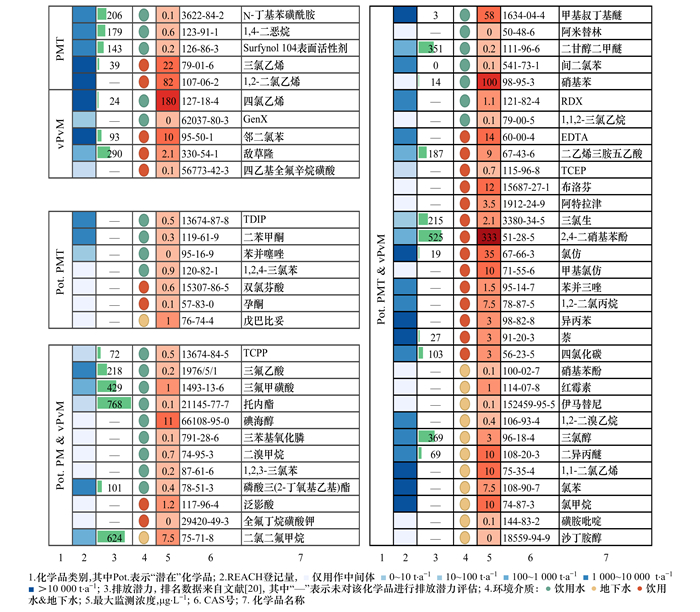随着《关于持久性有机污染物的斯德哥尔摩公约》化学品管控名单逐年增列及世界各国对持久性(persistent)、生物累积性(bioaccumulative)和毒性(toxic)类化学品(PBT)的逐步淘汰, 其环境和人体健康风险在全世界范围内正在得到逐步控制.近年来, 一类生物累积性较低但具持久性尤其在水环境中更具迁移性(mobile)和潜在毒性的化学品(PMT)或高度持久性和高度迁移性的化学品(vPvM), 即PMT/vPvM, 正在逐渐成为国际学术界和环保机构高度关注的新兴污染物[1].
现有研究显示, PMT/vPvM所涉物质种类众多、用途广泛, 包含个人护理品、药物以及涂料、油漆、阻燃剂等多种工业产品, 并且其中部分物质的生产、使用量巨大[2].PMT/vPvM进入自然环境后, 极易通过土壤层并穿透河岸等天然屏障沿着河流水道进入水生态系统, 在数周或更长时间尺度上迁移[1].持久性和迁移性的结合使此类化学品在饮用水净化、污水处理厂或生物降解和地下水过滤等过程中很难被去除, 随着时间推移PMT/vPvM浓度将在水体中不断增加, 对生态系统和人类健康构成了潜在的风险[3~5].当前, PMT/vPvM化学品已被欧盟健康、环境和新兴风险科学委员会(scientific committee on health, environmental and emerging risks, SCHEER)列为未来可能影响人类健康和环境的14个新兴问题之一[6], 并且欧盟化学品注册、评估、许可和限制法规(REACH)和物质和混合物分类、标签和包装法规(CLP)均提出需要加强对PMT/vPvM化学品的审查监管[7, 8].
本文旨在系统梳理和分析当前PMT/vPvM的现有鉴别标准、物质清单、排放强度和环境暴露等风险评估研究现状以及风险管理政策趋势, 展望未来PMT/vPvM风险科学研究与管理的需求和挑战.
1 PMT/vPvM鉴别标准、种类和物质清单 1.1 定义和鉴别标准PMT/vPvM与大多数定期监测和管制的污染物最大区别体现在, 其水生环境中的迁移性本质上与强极性有关[9].早期学术界尚未对“迁移性”作出确切定义和量化, 大多使用“极性(polar)”如持久性极性污染物(P3)[10]、极性持久性有机污染物(polar-POPs/P-POPs)[11]描述, 后发现个别非极性分子也可在水中远距离移动[12], 极性不再适用于此类化学品的通用内在属性.目前国际上主要采用Neumann等[13]提出的持久性、迁移性及毒性和高度持久、高度迁移特性的物质定义, 将其简称为PMT/vPvM; 此外, 也有研究者将持久性和迁移性有机污染物(persistent, mobile organic contaminants, PMOC)[14, 15]作为统称开展相关研究.
德国环境署(Umweltbundesamt, UBA)通过多年开展的PMT/vPvM物质特性研究、模型优先级审查、决策工具模型开发以及对REACH注册物质进行全面性评估[16], 提出了如表 1所示的PMT/vPvM鉴别标准[17].
|
|
表 1 UBA-PMT/vPvM的鉴别标准 Table 1 Current evaluation criteria for UBA-PMT/vPvM |
由表 1可见, 在PMT/vPvM鉴别标准中, 持久性(P)的鉴定方法与PBT物质相同, 毒性(T)是在REACH附件Ⅹ Ⅲ 1.1.3规定指标以外增加了其他与人类健康和环境风险有关的限制条件, 而迁移性(M)则是最新定义和量化的受关注物质特性.近年来, 科学界关于如何定义与量化迁移性(M)内在物质特征进行了广泛讨论, 包括众多指标如水溶性(Sw)、辛醇-水分配系数(Kow)、土壤-水分配系数(Kd)和有机碳-水分配系数(Koc)等[15].由于有机碳通常是土壤和沉积物中诸多中性化合物和离子化合物的吸附相, 且该参数对于不同土壤的变异性小于Kd, 故目前对M/vM的评估大都基于lg Koc指标.需要注意的是, 离子化合物与不同类型有机碳间相互作用差异较大, 尤其阳离子化合物易与带负电荷的土壤和矿物质表面吸附使迁移性降低, 导致不同环境下Koc测量值变化较大[18].目前, 国际上主要根据批次实验结果, 将在实际土壤、水体沉积物和污泥中测得的最小lg Koc值作为迁移性参考指标[19].
1.2 物质种类和优先清单基于定量构效关系(quantitative structure-activity relationship, QSAR)模型对欧盟登记的工业化学品的评估研究表明, 按照REACH早期关于化学物质持久性和迁移性的最低标准, 即淡水中半衰期>40 d和pH在4~10范围内lg Koc<4.5, 有5 155种工业化学品可被初步鉴定为PM类有机化学品(PMOC)[15], 其中具有较高持久性和迁移性的化学品及其前体物约有2 167种[20].UBA按照如表 1所示的评估标准对欧盟REACH登记的现有15 469种化学品进行评估表明, 至少有260种符合PMT/vPvM标准, 224种符合PM标准, 有2 377种因数据不足有待进一步评估; 在已鉴别的PMT/vPvM中, 有122种化学品需要优先给予进一步地调查以采取风险管理措施[19].
由于PMT/vPvM监测方法较为有限, 学术界对于自然环境中此类化学品的存在状况迄今尚未充分了解.Neumann等[17]对2000~2018年期间文献报道的饮用水和地下水环境中监测到的化学品进行甄别, 得出333种PMT/vPvM污染物清单, 其中有142种化学品在REACH中登记备案.Neuwald等[21]在德国的两条河流中开展环境监测, 识别出64种可疑PM化学品(<1~10 000ng·L-1), 主要有含氮化合物(44种)、磺酸盐(14种)和离子液体(20种).
基于现有筛选和监测研究, 不同研究机构和国际组织给出了一系列重点关注的PMT/vPvM(及潜在)清单[17, 20~23].其中, 国际非政府组织ChemSec列出了包括三聚氰胺、1, 4-二烷和四氯化碳等在内的35种PMT/vPvM名录[23], 部分在REACH中登记量超过100 t·a-1的PMT/vPvM及其应用范围见表 2.由此可见, PMT/vPvM种类多样, 主要作为阻燃剂、增塑剂、表面活性剂、乳化剂和杀虫剂等, 广泛应用于家具材料、塑料用品、家用护理品、电子电器和农药生产等领域.
|
|
表 2 ChemSec-高产量PMT/vPvM化学品清单1) Table 2 High-yield PMT/vPvM chemical list from ChemSec |
2 PMT/vPvM的环境排放、归趋与暴露 2.1 环境排放
PMT/vPvM种类众多, 环境排放源广泛.根据当前已识别的主要化学品清单及应用领域, 农田径流、工业废水和生活污水是PMT/vPvM主要环境排放源.此类化学品难以在常规的污水处理条件下去除, 而通常情况下污水处理厂作为连接人类生产生活和自然水体环境的纽带, 目前被认为是PMT/vPvM环境排放的主要途径[24, 25].
Schulze等[20]以REACH注册数据为参数开发了化学品定性排放评分系统, 对登记的2 167种潜在的PM化学品排放潜力进行建模排序, 结合文献调研发现, 三聚氰胺、双酚S、安赛蜜和糖精等高排放潜力的PM化学品在水体中均被广泛检出.值得关注的是, 有研究表明三聚氰胺已成为我国华南地区生活污水和受纳水体中的首要污染物, 其在生活污水中浓度是目前已知水环境中三聚氰胺最高报道水平(μg·L-1)[24].此外, 现有监测研究发现甲基叔丁基醚[26]、乙二胺四乙酸[27]、全氟丙酸酐[28]和三氟乙酸[29]等PMT/vPvM已广泛存在于地表水和饮用水源地中.
大量工业化学品、药物和个人护理品在生产生活中广泛使用并通过工业废水与生活污水排放到自然环境, 河流作为主要的环境纳污介质和污染物转化场所, 在人类活动影响下成为PMT/vPvM的流动载体.PMT/vPvM通过直排、经污水处理厂处理和部分渗透作用等途径进入河流地表水和地下水环境, 以自来水厂为主要汲水设施再次流通进入生产、生活流程.因此, 在水加工、处理过程中几乎均有PMT/vPvM的存在.例如, Sjerps等[3]对荷兰水样在污水处理厂流出物到地表水、再到地下水并最终进入饮用水环节开展了系统性分析, 发现尽管总有机污染物浓度水平下降两个数量级, 但迁移性(极性)最强的PMT/vPvM在整个过程水样中一直被检出.基于当前对PMT/vPvM排放来源、途径及归趋的认识, 城镇人居环境水循环系统中的PMT/vPvM环境排放与归趋过程可归纳如图 1所示.

|
改自文献[14, 30] 图 1 城镇人居环境水循环系统中的PMT/vPvM环境排放与归趋过程 Fig. 1 PMT/vPvM environmental emission and fate in the water circulation system of urban residential |
目前, 环境中仍有众多潜在PMT/vPvM环境监测方法存在空白或亟需完善, 大量未知和潜在的PMT/vPvM环境暴露水平尚不明确.本文结合Schulze等[20]评估的PMT/vPvM排放潜力排序和Neumann等[17]对饮用水和地下水环境中PMT/vPvM甄别筛选研究, 包括已识别及潜在的PMT/vPvM种类、现存环境介质及有数据记载的最高浓度水平, 归纳分析得到图 2所示常见PMT/vPvM的环境排放强度和暴露水平.从中可知, 众多PMT/vPvM环境浓度均达到μg·L-1级别, 且对多数化学品来说, 其排放潜力越大(即图 2中第3列数值越小)浓度水平越高.

|
图 2 饮用水和地下水中部分PMT/vPvM化学品环境排放和暴露水平 Fig. 2 Environmental emissions and exposure levels of some PMT/vPvM chemicals in drinking water and groundwater |
现有研究显示, 我国水生环境已受不同种类、不同浓度水平PMT/vPvM污染, 三聚氰胺、三聚氰酸、安赛蜜和短链全氟化合物等在地表水和地下水中均被检出[30]; 近年来在我国地表水、地下水及饮用水检测到的药物及个人护理品中, 超过三分之一具有或很可能具有PMT/vPvM特征, 其中抗生素、消炎镇痛药和杀菌类药物是主要的潜在PMT/vPvM化学品[31].
在科学界对PMT/vPvM化学品的持续关注下, 正有越来越多的PMT/vPvM从环境中被检测识别出来.例如, Neuwald等[21]在德国河流中检测到的新兴化学品金刚烷胺, 虽然其在工业应用方面较为封闭导致以往研究中报道浓度水平较低, 但该化学品近年来作为治疗帕金森病和病毒感染(包括SARS-CoV-2)的药物而被人群服用代谢后出现在水生态系统中[32, 33].PMT/vPvM和PBT/vPvB化学品在时间和空间上归趋行为不同, 人类和环境暴露途径存在差异.PMT/vPvM化学品的高迁移性决定了其主要分布于水生环境中, 可在(半)封闭的饮用水循环和原始水生环境中积累, 而PBT/vPvB化学品具有生物蓄积特性导致在人群和食物链中存在积累效应.应该注意到, 两类化学品的长时间、远距离运输和暴露风险均较难精准预测[25].
长期存在于水生态系统中的PMT/vPvM将会对流域系统内动、植物及饮用水系统内的人群产生潜在影响, 然而当前PMT/vPvM环境暴露及相应环境和健康风险的研究仍较为缺乏[9, 14, 20, 21, 34].以曾经在中国制造出”毒奶粉”事件的三聚氰胺为例, 该化学品在工业上主要用于合成树脂类衍生物, 作为阻燃剂和防水剂添加到厨具、塑料、地板和纺织产品中, 且具有亲水性和高度的迁移性, 其环境排放潜力在2000余种PMOC中位列前10[20], 近期已被提议列入REACH中高关注物质清单(substances of very high concern, SVHC)[35].三聚氰胺已被证实能够从由三聚氰胺-甲醛树脂制成的餐具中向外迁移进入人体和自然环境[36, 37], 其本身及其降解产物三聚氰酸对藻类、鱼类和虾等水生生物具有低毒性[38, 39], 对雄性小鼠具有一定的生殖毒性作用[40], 人类长期暴露于三聚氰胺将会增加肾结石患病风险[41].其他常见的高产量PMT/vPvM如工业溶剂1, 4-二烷在饮用水中被广泛检出, 美国环保署(USEPA)已将其列入“高优先级”化学品管控清单, 归类为“可能对人类致癌”化学品, 且饮用水摄入为人体潜在暴露途径, 当人体终生暴露于含有350 ng·L-1浓度1, 4-二烷的饮用水中时将会增加癌症发生几率[42, 43].
3 PMT/vPvM的风险管理趋势欧盟是PMT/vPvM概念提出和风险管理行动的主要发动者.目前, 欧盟化学品管理部门正在推动将PMT/vPvM类别和鉴别标准纳入欧盟CLP法规中, 从而创建一个新的化学品危害性类别和标准[7]; 并进一步修订REACH法规, 将PMT/vPvM明确列为SVHC以加强登记管理[44].为此, 欧盟在尝试建立新的模型或完善实验方法, 以识别和筛选REACH法规内登记在册物质中的PMT/vPvM.目前, 已有21种PMT/vPvM被纳入到欧盟REACH的SVHC清单或作为欧盟水质框架的优先关注物质[19].
欧盟“地平线2020”(Horizon 2020)计划资助启动了ZeroPM项目, 全面开展环境中PMT/vPvM包括多氟和全氟烷基化合物(poly-and perfluoroalkyl substances, PFAS)在内的化学品安全替代、优先识别、风险评估及修复去除等研究[45]; 为实现《欧洲绿色协议》目标而设立的PROMISCES项目则主要关注高持久性和迁移性PFAS, 提供创新技术减少环境中的PM污染, 以建立土壤-沉积物-水环境系统相关的可持续发展和循环经济路线[46].
北美关于PMT/vPvM的管控行动目前主要集中在PFAS上.美国环保署(USEPA)于2021年发布了PFAS战略路线图[47], 拟通过增加研究资金、限制环境排放和加快污染治理等指导策略, 以管控包含Gen-X和全氟丁烷磺酸(perfluorobutane sulfonic acid, PFBA)等在内的高持久性和迁移性PFAS.美国各州已发布多项提案, 禁止在食品包装、消防防护装备及灭火泡沫等产品中使用PFAS[48].此外, 在安全饮用水法(safe drinking water act, SDWA)的监管下, EPA发布“第5项不受管制的污染物监测规则”(fifth unregulated contaminant monitoring rule, UCMR 5), 进一步计划对全国范围内饮用水中的29种PFAS进行扩大监测, 保护饮用水安全和公众健康[49].
4 结论与展望(1) PMT/vPvM正在成为继POPs及PBT类化学品之后国际化学品风险评估与风险管理的关注热点.目前, 国际上已经形成了比较明确的PMT/vPvM鉴别标准; 结合理论推算和环境监测数据分析, 初步确定了其物质范畴以及优先关注物质清单; PMT/vPvM在城镇人居环境水循环系统中的环境排放和归趋过程, 尤其是其持续循环与积累的过程正逐渐明晰; 一系列优先关注的高产量/排放量的PMT/vPvM环境暴露及环境和健康风险已日趋凸显; 欧盟等化学品风险管理先进的地区和国家, 正逐步将PMT/vPvM专门纳入现行化学品风险管理体系中的优先范畴.
(2) 因所涉物质种类众多, 迄今已识别的PMT/vPvM还仅占现有登记化学品的一小部分, PMT/vPvM化学品的评估鉴别和清单确定仍将是未来学术界面临的一项重要且长期的任务.环境监测数据是PMT/vPvM化学品评估鉴别的重要基础条件, 但其目前主要受限于监测方法的欠缺, 各类新兴和潜在PMT/vPvM的监测方法开发和应用将成为未来较为迫切的研究需求.从当前总体研究进展来看, 除欧盟等个别地区及PFAS等个别物质类别之外, 全球不同地区及更广泛的PMT/vPvM环境分布和暴露水平的研究尚十分有限, 其以低浓度产生的潜在、长期的生态毒性和人体健康危害效应的研究更为匮乏.因此, PMT/vPvM(尤其是高产量/排放的高关注物质)的区域和全球环境暴露及其生态和人体健康危害效应的评估研究亟待开展, 这将成为未来区域及全球PMT/vPvM风险管理决策的重要前提.与此同时, PMT/vPvM替代品或替代技术, 以及污水处理厂去除等环境工程治理技术的研发, 也必将成为未来重要的研究方向.
| [1] | Neumann M, Schliebner I. Protecting the sources of our drinking water from mobile chemicals- A revised proposal for implementing criteria and an assessment procedure to identify Persistent, Mobile and Toxic (PMT) and very Persistent, very Mobile (vPvM) substances registered under REACH[R]. Dessau-Roẞlau, Germany: UBA, 2017. |
| [2] | Rockett L, McArdle R, Bull S, et al. Persistent, mobile and toxic substances-hazards to drinking water in England and Wales[R]. Wiltshire: Water Research Centre Limited, 2020. |
| [3] | Sjerps R M A, Vughs D, van Leerdam J A, et al. Data-driven prioritization of chemicals for various water types using suspect screening LC-HRMS[J]. Water Research, 2016, 93: 254-264. DOI:10.1016/j.watres.2016.02.034 |
| [4] | van der Hoek J P, Bertelkamp C, Verliefde A R D, et al. Drinking water treatment technologies in Europe: state of the art-challenges-research needs[J]. Journal of Water Supply: Research and Technology-Aqua, 2014, 63(2): 124-130. DOI:10.2166/aqua.2013.007 |
| [5] | Filipovic M, Berger U. Are perfluoroalkyl acids in waste water treatment plant effluents the result of primary emissions from the technosphere or of environmental recirculation?[J]. Chemosphere, 2015, 129: 74-80. DOI:10.1016/j.chemosphere.2014.07.082 |
| [6] | Bertollini R, Borges T, de Jong W, et al. Statement on emerging health and environmental issues (2018)[R]. Brussels, Belgium: European Commission, 2018. |
| [7] | EEB, HEAL. EEB and HEAL comments on the draft PMT/vPvM criteria for CLP[EB/OL]. https://www.env-health.org/wp-content/uploads/2021/10/EEB-and-HEAL-Comments-on-the-draft-PMT.pdf, 2022-04-26. |
| [8] | Hale S E, Neumann M, Schliebner I, et al. Getting in control of persistent, mobile and toxic (PMT) and very persistent and very mobile (vPvM) substances to protect water resources: strategies from diverse perspectives[J]. Environmental Sciences Europe, 2022, 34(1). DOI:10.1186/S12302-022-00604-4 |
| [9] | Zahn D, Neuwald I J, Knepper T P. Analysis of mobile chemicals in the aquatic environment-current capabilities, limitations and future perspectives[J]. Analytical and Bioanalytical Chemistry, 2020, 412(20): 4763-4784. DOI:10.1007/s00216-020-02520-z |
| [10] | van der Voet E, Nikolic I, Huppes G, et al. Integrated systems analysis of persistent polar pollutants in the water cycle[J]. Water Science and Technology, 2004, 50(5): 243-251. DOI:10.2166/wst.2004.0334 |
| [11] | Loos R, Gawlik B M, Locoro G, et al. EU-wide survey of polar organic persistent pollutants in European river waters[J]. Environmental Pollution, 2009, 157(2): 561-568. DOI:10.1016/j.envpol.2008.09.020 |
| [12] | Hale S E, Arp H P H, Schliebner I, et al. What's in a name: persistent, mobile, and toxic (PMT) and very persistent and very mobile (vPvM) substances[J]. Environmental Science & Technology, 2020, 54(23): 14790-14792. |
| [13] | Neumann M, Schwarz M A, Sättler D, et al. A proposal for a chemical assessment concept for the protection of raw water resources under REACH[R]. Dessau-Roẞlau, Germany: UBA, 2015. |
| [14] | Reemtsma T, Berger U, Arp H P H, et al. Mind the gap: persistent and mobile organic compounds-water contaminants that slip through[J]. Environmental Science & Technology, 2016, 50(19): 10308-10315. |
| [15] | Arp H P H, Brown T N, Berger U, et al. Ranking REACH registered neutral, ionizable and ionic organic chemicals based on their aquatic persistency and mobility[J]. Environmental Science: Processes & Impacts, 2017, 19(7): 939-955. |
| [16] | UBA. Emergence of the PMT/vPvM criteria[EB/OL]. https://www.umweltbundesamt.de/en/emergence-of-the-pmtvpvm-criteria, 2022-04-26. |
| [17] | Neumann M, Schliebner I. Protecting the sources of our drinking water: the criteria for identifying persistent, mobile and toxic (PMT) substances and very persistent and very mobile (vPvM) substances under EU Regulation REACH (EC) No 1907/2006[R]. Dessau-Roẞlau, Germany: UBA, 2019. |
| [18] | Droge S T J, Goss K U. Development and evaluation of a new sorption model for organic cations in soil: contributions from organic matter and clay minerals[J]. Environmental Science & Technology, 2013, 47(24): 14233-14241. |
| [19] | Arp H P H, Hale S E. REACH: improvement of guidance and methods for the identification and assessment of PMT/vPvM substances[R]. Dessau-Roẞlau, Germany: UBA, 2019. |
| [20] | Schulze S, Sättler D, Neumann M, et al. Using REACH registration data to rank the environmental emission potential of persistent and mobile organic chemicals[J]. Science of the Total Environment, 2018, 625: 1122-1128. DOI:10.1016/j.scitotenv.2017.12.305 |
| [21] | Neuwald I, Muschket M, Zahn D, et al. Filling the knowledge gap: a suspect screening study for 1310 potentially persistent and mobile chemicals with SFC- and HILIC-HRMS in two German river systems[J]. Water Research, 2021, 204. DOI:10.1016/j.watres.2021.117645 |
| [22] | Schymanski E, Wang Z Y, Wolf R, et al. S90 | ZEROPMBOX1 | ZeroPM box 1 substances[EB/OL]. https://zenodo.org/record/5854252#.YkRR--hByUk, 2022-03-19. |
| [23] | Chem Sec. SINLIST[EB/OL]. https://sinlist.chemsec.org, 2022-04-13. |
| [24] | Liu S S, Cai Q S, Li C L, et al. In situ measurement of an emerging persistent, mobile and toxic (PMT) substance-melamine and related triazines in waters by diffusive gradient in thin-films[J]. Water Research, 2021, 206. DOI:10.1016/j.watres.2021.117752 |
| [25] | Liu S S, Chen S B, Li X H, et al. Development and application of diffusive gradients in thin-films for in situ sampling of the bitterest chemical-denatonium benzoate in waters[J]. Journal of Hazardous Materials, 2021, 418. DOI:10.1016/j.jhazmat.2021.126393 |
| [26] | Achten C, Kolb A, Püttmann W. Occurrence of methyl tert-butyl ether (MTBE) in riverbank filtered water and drinking water produced by riverbank filtration. 2[J]. Environmental Science & Technology, 2002, 36(17): 3662-3670. |
| [27] | Schmidt C K, Fleig M, Sacher F, et al. Occurrence of aminopolycarboxylates in the aquatic environment of Germany[J]. Environmental Pollution, 2004, 131(1): 107-124. DOI:10.1016/j.envpol.2004.01.013 |
| [28] | Eschauzier C, Beerendonk E, Scholte-Veenendaal P, et al. Impact of treatment processes on the removal of perfluoroalkyl acids from the drinking water production chain[J]. Environmental Science & Technology, 2012, 46(3): 1708-1715. |
| [29] | Scheurer M, Nödler K, Freeling F, et al. Small, mobile, persistent: trifluoroacetate in the water cycle-Overlooked sources, pathways, and consequences for drinking water supply[J]. Water Research, 2017, 126: 460-471. DOI:10.1016/j.watres.2017.09.045 |
| [30] |
刘艺, 于洋, 金彪, 等. 持久、迁移性有机污染物的水污染现状、分析检测方法和去除技术[J]. 地球化学, 2021, 50(3): 305-316. Liu Y, Yu Y, Jin B, et al. Persistent and mobile organic contaminants: water pollution, analytical approaches and removal techniques[J]. Geochimica, 2021, 50(3): 305-316. |
| [31] | Huang C, Jin B, Han M, et al. The distribution of persistent, mobile and toxic (PMT) pharmaceuticals and personal care products monitored across Chinese water resources[J]. Journal of Hazardous Materials Letters, 2021, 2. DOI:10.1016/j.hazl.2021.100026 |
| [32] | Schulze S, Zahn D, Montes R, et al. Occurrence of emerging persistent and mobile organic contaminants in European water samples[J]. Water Research, 2019, 153: 80-90. DOI:10.1016/j.watres.2019.01.008 |
| [33] | Xue M, Wu H C, Liu S Y, et al. Simultaneous determination of 44 pharmaceutically active compounds in water samples using solid-phase extraction coupled with ultra-performance liquid chromatography-tandem mass spectrometry[J]. Analytical and Bioanalytical Chemistry, 2020, 412(1): 203-222. DOI:10.1007/s00216-019-02229-8 |
| [34] | Hale S E, Arp H P H, Schliebner I, et al. Persistent, mobile and toxic (PMT) and very persistent and very mobile (vPvM) substances pose an equivalent level of concern to persistent, bioaccumulative and toxic (PBT) and very persistent and very bioaccumulative (vPvB) substances under REACH[J]. Environmental Sciences Europe, 2020, 32(1). DOI:10.1186/s12302-020-00440-4 |
| [35] | Hogue C. Melamine targeted for possible regulation in the EU[EB/OL]. https://cen.acs.org/environment/Melamine-targeted-possible-regulation-EU/100/i24, 2022-07-14. |
| [36] | Takazawa M, Suzuki S, Kannan K. Leaching of melamine and cyanuric acid from melamine-based tableware at different temperatures and water-based simulants[J]. Environmental Chemistry and Ecotoxicology, 2020, 2: 91-96. DOI:10.1016/j.enceco.2020.07.002 |
| [37] | Kim H S, Lee Y J, Koo Y J, et al. Migration of monomers, plastic additives, and non-intentionally added substances from food utensils made of melamine-formaldehyde resin following ultraviolet sterilization[J]. Food Control, 2021, 125. DOI:10.1016/j.foodcont.2021.107981 |
| [38] | Phromkunthong W, Nuntapong N, Wanlem S, et al. A study on growth, histopathology and oxidative stress in Asian sea bass on diets with various loadings of melamine and cyanuric acid adulterants[J]. Aquaculture, 2015, 435: 336-346. DOI:10.1016/j.aquaculture.2014.10.009 |
| [39] | Nuntapong N, Phromkunthong W, Wanlem S, et al. Dietary exposure to melamine and cyanuric acid induced growth reduction, oxidative stress and pathological changes of hepatopancreas in Pacific white shrimp[J]. International Aquatic Research, 2019, 11(1): 13-31. DOI:10.1007/s40071-019-0216-y |
| [40] |
夏凤琼, 杨国珍, 黄健, 等. 三聚氰胺对雄性小鼠睾丸生精细胞凋亡的影响[J]. 贵州医科大学学报, 2019, 44(7): 781-785. Xia F Q, Yang G Z, Huang J, et al. Effect of melamine on apoptosis of spermatogenic cells in testis of male mice[J]. Journal of Guizhou Medical University, 2019, 44(7): 781-785. |
| [41] | Liu C C, Hsieh T J, Wu C F, et al. Interrelationship of environmental melamine exposure, biomarkers of oxidative stress and early kidney injury[J]. Journal of Hazardous Materials, 2020, 396. DOI:10.1016/j.jhazmat.2020.122726 |
| [42] | Adamson D T, Piña E A, Cartwright A E, et al. 1, 4-Dioxane drinking water occurrence data from the third unregulated contaminant monitoring rule[J]. Science of the Total Environment, 2017, 596-597: 236-245. DOI:10.1016/j.scitotenv.2017.04.085 |
| [43] | Stepien D K, Diehl P, Helm J, et al. Fate of 1, 4-dioxane in the aquatic environment: from sewage to drinking water[J]. Water Research, 2014, 48: 406-419. DOI:10.1016/j.watres.2013.09.057 |
| [44] | Rüdel H, Körner W, Letzel T, et al. Persistent, mobile and toxic substances in the environment: a spotlight on current research and regulatory activities[J]. Environmental Sciences Europe, 2020, 32(1). DOI:10.1186/s12302-019-0286-x |
| [45] | Hale S E. ZeroPM[EB/OL]. https://zeropm.eu/, 2022-05-30. |
| [46] | Negrel P, Lions J. PROMISCES[EB/OL]. https://promisces.eu/, 2022-04-26. |
| [47] | EPA. PFAS strategic roadmap: EPA's commitments to action 2021-2024[EB/OL]. https://www.epa.gov/system/files/documents/2021-10/pfas-roadmap_final-508.pdf, 2022-07-08. |
| [48] | SGS. 美国立法进展: 消费品中的PFAS[EB/OL]. https://www.sgsonline.com.cn/case/article/detail-1061.html, 2022-07-08. |
| [49] | EPA. Fifth unregulated contaminant monitoring rule[EB/OL]. https://www.epa.gov/dwucmr/fifth-unregulated-contaminant-monitoring-rule, 2022-07-08. |
 2023, Vol. 44
2023, Vol. 44


